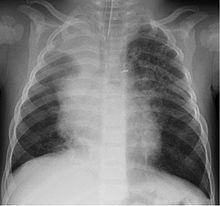HD 70930
HD 70930| 관측 데이터 에폭 J2000 이쿼녹스 J2000 | |
|---|---|
| 별자리 | 벨라 |
| 우측 상승 | 08h 22m 31.6941s[1] |
| 탈위임 | −48° 29′ 25.3631″[1] |
| 겉보기 크기(V) | 4.79[2] (5.14 + 6.08)[3] |
| 특성. | |
| 스펙트럼형 | B1V[4] 또는 B2III[5] |
| B-V색지수 | −0.146±0.002[2] |
| 아스트로메트리 | |
| 방사 속도(Rv) | +27.0±4.5km[2]/s |
| 적정운동(μ) | RA:−5.10±0.39[1]mas/yr Dec.:+7.76±0.33[1]mas/yr |
| 시차(시차) | 1.90 ± 0.32 마스[1] |
| 거리 | 약 1,700리 (약 530pc) |
| 절대치수(MV) | −3.74[2] |
| 세부 사항 | |
| 미사 | 15.6±0.8[4] M☉ |
| 루미도 | 6,833.12[2] L☉ |
| 회전 속도(v sin i) | 시속 169km[6] |
| 나이 | 10.0±0.1[4] 마이어 |
| 기타 지정 | |
| 데이터베이스 참조 | |
| 심바드 | 자료 |
HD 70930은 벨라의 남쪽 별자리에 있는 이진 항성계통이다[8].바이엘 명칭 B 벨로룸이 있으며, HD 70930은 헨리 드레이퍼 카탈로그에서 별의 식별자다.외관상 4.79의 시력 조합으로, 희미한 빛의 점으로서 육안으로 볼 수 있다.[2]이 계통까지의 거리는 시차 기준 약 1,700광년이며,[1] 절대폭은 -3.74이다.[2]그것은 약 +27 km/s의 방사 속도로 태양으로부터 더 멀리 떠내려가고 있다.[2]이 시스템은 함께 움직이는 별들의 벨 OB2 협회의 일원이다.[9]
이 체계의 이중성은 1896년 스코틀랜드의 천문학자 로버트 T. A. 이네스(Robert T. A. Innes[3])에 의해 발견되었는데, 현재 이 체계는 이중선 스펙트럼 분석 이진법으로 알려져 있다.[10]진도 5.14[3] 1차 성분은 청백색을 띠며 B1V와[4] B2의 별 분류를 할당받았다.III,[5] 각각 B형 주계열성 또는 거성별을 매칭한다.태양 질량의 15배가 넘는 거대한 물체로 약 천만년 된 것이다.[4]이 별은 높은 회전 속도를 가지고 있어 169km/s의 예상 회전 속도를 보여준다.[6]그것의 동반자는, 진도 +6.08로, 2008년 현재, 위치 각 139°를 따라 0.8°의 각이 분리되어 있다.[3]
참조
- ^ a b c d e f van Leeuwen, F. (2007). "Validation of the new Hipparcos reduction". Astronomy and Astrophysics. 474 (2): 653–664. arXiv:0708.1752. Bibcode:2007A&A...474..653V. doi:10.1051/0004-6361:20078357. Vizier 카탈로그 항목
- ^ a b c d e f g h Anderson, E.; Francis, Ch. (2012), "XHIP: An extended hipparcos compilation", Astronomy Letters, 38 (5): 331, arXiv:1108.4971, Bibcode:2012AstL...38..331A, doi:10.1134/S1063773712050015, S2CID 119257644.
- ^ a b c d e Mason, B. D.; et al. (2014), "The Washington Visual Double Star Catalog", The Astronomical Journal, 122 (6): 3466, Bibcode:2001AJ....122.3466M, doi:10.1086/323920
- ^ a b c d e Tetzlaff, N.; et al. (January 2011), "A catalogue of young runaway Hipparcos stars within 3 kpc from the Sun", Monthly Notices of the Royal Astronomical Society, 410 (1): 190–200, arXiv:1007.4883, Bibcode:2011MNRAS.410..190T, doi:10.1111/j.1365-2966.2010.17434.x, S2CID 118629873.
- ^ a b Houk, Nancy (1978), Michigan catalogue of two-dimensional spectral types for the HD stars, vol. 2, Ann Arbor: Dept. of Astronomy, University of Michigan, Bibcode:1978mcts.book.....H.
- ^ a b Uesugi, Akira; Fukuda, Ichiro (1970), "Catalogue of rotational velocities of the stars", Contributions from the Institute of Astrophysics and Kwasan Observatory, University of Kyoto, Bibcode:1970crvs.book.....U.
- ^ "HD 70930". SIMBAD. Centre de données astronomiques de Strasbourg. Retrieved 2019-10-06.
- ^ Eggleton, P. P.; Tokovinin, A. A. (2008). "A catalogue of multiplicity among bright stellar systems". Monthly Notices of the Royal Astronomical Society. 389 (2): 869. arXiv:0806.2878. Bibcode:2008MNRAS.389..869E. doi:10.1111/j.1365-2966.2008.13596.x. S2CID 14878976.
- ^ de Zeeuw, P. T.; et al. (January 1999), "A HIPPARCOS Census of the Nearby OB Associations", The Astronomical Journal, 117 (1): 354–399, arXiv:astro-ph/9809227, Bibcode:1999AJ....117..354D, doi:10.1086/300682, S2CID 16098861.
- ^ Chini, R.; et al. (2012), "A spectroscopic survey on the multiplicity of high-mass stars", Monthly Notices of the Royal Astronomical Society, 424 (3): 1925–1929, arXiv:1205.5238, Bibcode:2012MNRAS.424.1925C, doi:10.1111/j.1365-2966.2012.21317.x, S2CID 119120749.


